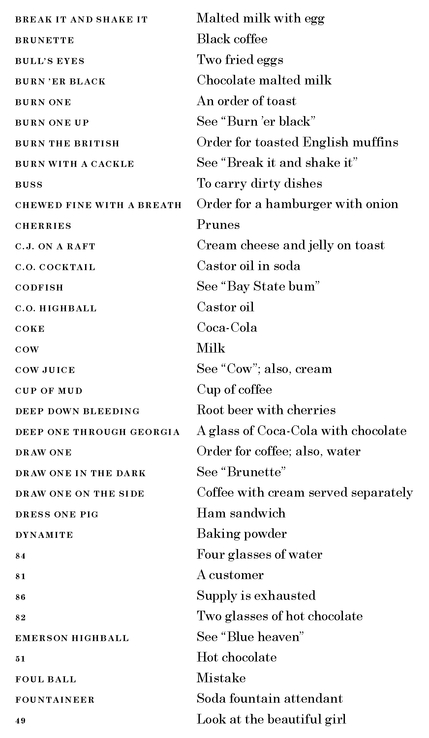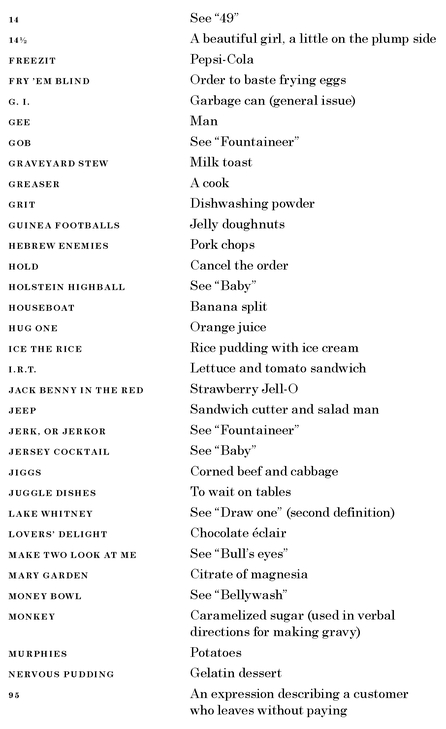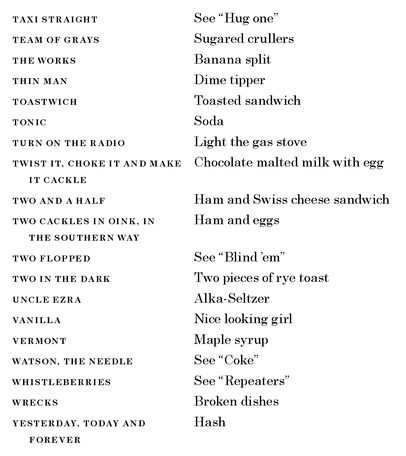The Food of a Younger Land (8 page)
Read The Food of a Younger Land Online
Authors: Mark Kurlansky


Ephemeral as all this may be, however, the modern literary tea has its points. It enables its devotees to renew old friendships and make new ones; it gives the publisher an opportunity to tip off the trade as to which writer he is going to push; it allows the ambitious young author to make contacts with editors; and it gives a great many people entertainment, not to mention free drinks, in the hours before dinner.
The Automat
EDWARD O’BRIEN
Although the Automat was thought of as a New York City institution, its founding company, Horn & Hardart, also usually associated with New York, was based in Philadelphia. A forerunner of fast food, automats were a rapidly growing trend in the early twentieth century. The idea of dispensing cafeteria food from coin slots originated in Germany. In Times Square in the summer of 1912 Horn & Hardart opened their first New York City Automat. Originally their only fare was fish cakes, beans, buns, and coffee, each of which was on display in little compartments with windows that opened if a nickel was put in the slot. By the time of
America Eats,
automats offered a wide range of food, but still each compartment opened with a nickel. They were well established in New York and became even more popular after the war, even in the 1950s, when they raised the prices of some items to a dime. But gradually fast-food restaurants eroded their following and in the 1980s Horn & Hardart closed many of their automats and replaced them with Burger King restaurants. In 1991 the last automat on 42nd Street and Third Avenue closed.
America Eats,
automats offered a wide range of food, but still each compartment opened with a nickel. They were well established in New York and became even more popular after the war, even in the 1950s, when they raised the prices of some items to a dime. But gradually fast-food restaurants eroded their following and in the 1980s Horn & Hardart closed many of their automats and replaced them with Burger King restaurants. In 1991 the last automat on 42nd Street and Third Avenue closed.
A
sight to the out-of-towner, and an honored institution among the city’s millions, is the mechanical lunchroom known to fame as the Automat. This type of self-service eating place is the result of deep probing into the needs of the five-minute metropolitan center. Here, the man-in-a-hurry is worried by no middle-men; his relationship with his fodder, over which he may gloat, ruminate, or despair, is strictly private. He selects, pays, conveys, eats, and departs, leaving no tip, uttering no sound.
sight to the out-of-towner, and an honored institution among the city’s millions, is the mechanical lunchroom known to fame as the Automat. This type of self-service eating place is the result of deep probing into the needs of the five-minute metropolitan center. Here, the man-in-a-hurry is worried by no middle-men; his relationship with his fodder, over which he may gloat, ruminate, or despair, is strictly private. He selects, pays, conveys, eats, and departs, leaving no tip, uttering no sound.
Two hundred and fifty thousand New Yorkers go through these silent processes daily in favorite or convenient Automats. Some are regular customers, others appear only on certain days, keeping a tryst with a favorite dish. No New York wife knows her husband until she has studied him in an Automat. And all suburban mothers have learned that on a day in town lunch at the Automat is the kids’ delight.
A stranger entering these precincts is led by the crowd toward a trim marble counter, in which are several plate-like depressions. A nickel is the unit of purchase, so coins or bills are here exchanged for scintillating showers of nickels, which are miraculously never too many, never too few. With a fistful of nickels, and wearing hat, coat, carrying brief-case or handbag, the crowd moves on toward the walls of food, assembling as they go trays, silver, and napkins.
Dozens of illuminated metal cubicles, separated from the hungry by little plate-glass doors, exhibit single servings of some edible. Prices in nickels are posted beside the glass door: Chicken Pie 4 nickels; Hot Mince Pie 2 nickels. The trick is to push the required number of nickels into the right slot, whisk out the food before the door slams shut again, and juggle the dish onto the tray, without dropping bags, parcels, or other belongings.
Beverage pumps require three operations. The cup or glass is placed under the spout, a nickel into the slot, a handle is pushed down, and carefully measured liquid sluices into the container—cream and coffee simultaneously in balanced proportions that are the result of many surveys and much research into man’s tastes. For orders of black coffee or tea, with or without cream or lemon, an attendant must be summoned to the cubbyhole, by ringing a bell after the nickel has been deposited.
As there are no discernible vacant places at the tables during rush hours, the title of “tray jockey” is bestowed on those skilled regulars who, through long practice in broken-field running, have become adept in the business of seat-snatching.
That Automat diners return daily to their trials is not due to love of punishment but to the fact that food here is hard to beat. The hot beef or chicken pies, baked in individual deep dishes and covered with brown and flaky crusts, are among the culinary wonders of New York—produced, as they are, in perfect and uniform thousands! And the piping-hot corned beef hash, made of honest lean beef and never too sharply flavored, is as good as any man’s mother can cook.
Clam chowder, not Boston-, not New York-style, but with a flavor all its own, and English beef soup, are both so popular as to keep trade rivals sniffing around. Little pots of slow-baked beans, garnished with strips of crisp pork, rival Boston’s and the door of their cell rattles like a machine gun all day long.
Thousands breakfast on the beloved cinnamon bun, a modestly named confection stuffed with raisins and covered with treacle. This, with a cup of excellent, rich-creamed coffee, inspires many a wan New Yorker to start the day with a glow. Bread, superior corn bread, bran muffins, pies, and pastries sit in the noble company of the cinnamon bun.
At the steam table the capricious may select a complete dinner, and though portions are not large, the food is better than that obtained at many cafeterias. But the nickel-in-the-slot method is still the more popular.
Quality never varies. This accounts for the loyalty of the regulars. Such achievement in mass-production cookery is credited in part to organization, in part to a staff of the most highly paid chefs in the business. And food buying is so closely gauged that there are no left-overs at the end of the day, which is 2 a.m.
New York eats in the Automat; it does not, however, smoke or converse there. Smoking, in fact, is strictly forbidden by sign and spoken warnings. But no one minds. The Automat will flourish so long as the average New Yorker remains what he is, a person who is everlastingly fond of dropping coins into slot machines, who loves good coffee, and who knows his cinnamon buns.
New York Soda-Luncheonette Slang and Jargon





Drugstore Lunch
EDWARD O’BRIEN
T
ime was when the drug store dispensed medicines. But now, as the candid rag says with but slight exaggeration, it sells everything from pins to automobiles. Not the least of the additions to the drug store is the soda-fountain luncheonette, where anything from a “C.O. cocktail” (castor oil in soda) to “Jack Benny in the red” (strawberry Jell-O) may be had.
ime was when the drug store dispensed medicines. But now, as the candid rag says with but slight exaggeration, it sells everything from pins to automobiles. Not the least of the additions to the drug store is the soda-fountain luncheonette, where anything from a “C.O. cocktail” (castor oil in soda) to “Jack Benny in the red” (strawberry Jell-O) may be had.
The stool and counter has a special attraction for the woman shopper, the office worker, and the show girl. And it has certain advantages. The drug store carries a connotation of cleanliness. One juggles no tray while stalking a seat in the noonday jam. The food, though slightly more expensive than that served in the cafeteria, is light, tasty, and briskly served. Again, the store specializes in odd knick-knacks, the delight of feminine customers who would ordinarily turn away from heavier fare. Above all, it has glorified the sandwich.
The
pièce de résistance
is the toasted “three decker” enclosing ’tween decks unusual and sometimes insidious food combinations. These may include cold meats, fish mixtures called “salads,” hamburger, bacon, cheese, jelly, peanut butter, bananas, tomatoes, relish, pickles, and chopped eggs, all garnished with condiments or dressings. The popular cheese-burger is a doughty bit combining grilled hamburger and melted American cheese served on a soft bun and tasty enough to ensnare even the one-cylinder appetite.
pièce de résistance
is the toasted “three decker” enclosing ’tween decks unusual and sometimes insidious food combinations. These may include cold meats, fish mixtures called “salads,” hamburger, bacon, cheese, jelly, peanut butter, bananas, tomatoes, relish, pickles, and chopped eggs, all garnished with condiments or dressings. The popular cheese-burger is a doughty bit combining grilled hamburger and melted American cheese served on a soft bun and tasty enough to ensnare even the one-cylinder appetite.
In New York’s summer heat the customer may “drink” his lunch, in which case he has a wide choice of cold drinks and ice cream. Or he may dawdle over the substantial banana split, variously known back-counter as a “house boat” or “the works,” constructed of ice cream, strawberries, crushed pineapple, whipped cream, maraschino cherries, and chopped nuts, all resting heavily on the banana. Cold weather brings hot beef tea, Ovaltine, tea, coffee, chocolate, and hot milk.
Hot miniature dinners are sometimes offered: chilled fruit juice, a bowl of excellent soup, a salad, and such entrées as boiled beef tongue with raisin gravy, potato and spinach, or chow mein with rice and noodles—even leg of lamb with potato, diced carrots and mint jelly. Desserts include everything from plain pie to the hot fudge Mary Ann. All this may be had for a very reasonable fixed price.
Other books
The Accidental Mrs. Mackenzie by Winn, Bonnie K.
The Physics of War by Barry Parker
Class Reunion by Juliet Chastain
Tale of Gwyn by Cynthia Voigt
The Last Good Knight by Tiffany Reisz
Precedent: Book Three: Covenant of Trust Series by Paula Wiseman
Accidentally Evil by Lara Chapman
A Hundred Pieces of Me by Lucy Dillon
Speaking in Tongues by Jeffery Deaver
Star Time by Amiel, Joseph
